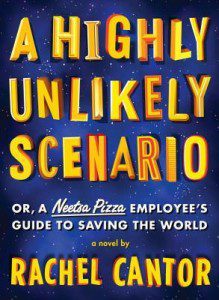
I.
Hear that knock on the door or phone ringing—it’s adventure calling. It might be Gandalf or Morpheus from the Matrix or, in this case, Isaac the Blind, an old Jewish mystic who’s dialing up our hero from centuries past, calling on him to, you know, well, abandon the dullness of daily life and rescue the world from some kind of obliteration. It’s a request made in Rachel Cantor’s delightful first novel, A Highly Unlikely Scenario Or, a Neetsa Pizza Employee’s Guide to Saving the World.
Our hero is Leonard, a Listener for Neetsa Pizza. Leonard fields the calls from complainers, offering them a sympathetic ear and coupons for free pizzas, delicious pies such as the Golden Mean and Neoplatonist, cheesy treats that pacify the masses. Leonard lives in a world you might be familiar with. It’s a technodystopia, ruled by Corporate Speak, consumerism, and warring fast food factions, each of which has its own philosophical angle. Neetsa Pizza is heir to Pythagoras’s wisdom. Leonard’s sister, on the other hand, works for Jack-o-Bites, a Scottish joint that slings haggis and Jacobitism, a U.K. ideology involving the divine right of kings—although secretly she is a Neo-Maoist.
This is a world we’re seeing with increasing frequency. From Infinite Jest to George Saunders’s short stories to movies like Idiocracy, the technodystopia deals in zany satire and gross amounts of consumer culture. Instead of being unremittingly bleak like the dystopian landscape of Orwell’s 1984, these technodystopias are oddly colorful. They’re barely parodies of our extravagant 21st-century lives. In a sense, they continue the tradition of Huxley’s Brave New World by way of Kurt Vonnegut’s black comedy.
To understand dystopia today, it’s helpful to look at 1984 and Brave New World as two opposing visions. While Orwell’s dystopian vision of totalitarian governments and constant oppression is seen in popular texts like The Hunger Games and V for Vendetta, in literary fiction we see that Huxley’s dystopian vision is more prevalent. Here, as Neil Postman writes, “people will come to love their oppression, to adore the technologies that undo their capacities to think.” The number of novels and stories exploring this vision grows each year. There’s Infinite Jest (1996), Oryx and Crake (2003), Super Sad True Love Story (2010), all four of George Saunders’s collections (1996, 2000, 2006, and 2013), and now Cantor’s A Highly Unlikely Scenario, just to name a few.
While the settings in these novels and stories are intriguing, they’re not entirely unique. There are some common themes that run throughout. These technodystopias look at consumer culture, the stupidity of mass media, life in an age of excessive information, and our societal obsession with technology. Oppression is engendered not through secret police and military crack-downs, but through the characters’ adherence to capitalism and computers. Plus there’s the comedy. Writers like Wallace, Shteyngart, and Cantor are all funny, and by using these technodystopian settings they can amp up the satire, maximizing their strengths as writers. The funnier dystopia is, the more likely it resembles real life.
We shouldn’t be surprised by these similarities. As different writers try to make sense of the world, they often come to similar conclusions about what forces are shaping our lives and, thus, the future. Here are four trademarks of the technodystopia (all examples are from A Highly Unlikely Scenario):
- The use of Corporate Speak, where key nouns are capitalized to create the impression that the characters’ lives could also exist in marketing brochures. (“He [Leonard] was perfectly fulfilled in his White Room, and joyous in his Life Plan, which was to heal clients-in-pain.”)
- Parodies of TV shows, videogames, and/or the Internet (A literary-historical device known as the Brazen Head becomes a retroactive parody of Wikipedia, spewing out any information requested of it in a hip manner.)
- A lambasting of consumer culture (Companies like the “Heraclitan Grill” and “Neetsa Pizza” control the world while, as Leonard’s sister exclaims, “Pythagorean pizza is the opiate of the middle class!”)
- Person vs. technology is a major conflict, often the most thematically important one. (The first third of the novel revolves around drama involving Leonard and his telephone.)
Examples of these four trademarks could’ve been pulled from any of the works mentioned above, or from most of today’s literary speculative fiction. Writers’ use of these trademarks to engage common themes shows a united desire to confront life today—to deal with the fact that, as Evgeny Morzov says, we’re on a crash course with technological solutionism, where corporations’ promise to save the world via new apps and other bullshit is seriously messing up society, along with everything else. Given the frequency with which we’re now encountering these technodystopian settings in American fiction, it is necessary to consider the aesthetic limitations often found in such worlds, especially since these worlds do not seem so unusual or far-off.
II.
“The American writer,” Philip Roth writes, “has his hands full in trying to understand, describe, and then make credible much of American reality. It stupefies, it sickens, it infuriates, and finally is even kind of an embarrassment to one’s meager imagination.” This statement feels truer today than it ever could have back when Roth wrote it in 1961, which is why we so often find ourselves in the mayhem of the not-too-distant future.

By employing these technodystopian settings, with stories set in the HelthWyzer corporate compound or the Year of the Depend Adult Undergarment, writers are able to stay ahead of the curve. They can outpace current American reality by leaping ahead 40 years and adding in a sizable portion of technologically induced societal collapse. Such a maneuver allows writers to escape the blandness of suburban realism, where descriptions of kitchen appliances and potato chips still predominate, and to immediately engage us with questions about consumerism, media, technology, and capitalism. Our writers, in short, do their best to maintain credibility. The trouble is that our relationships with the forces of technology and capitalism are incredibly complex, but when placed in a technodystopian setting they often get simplified, turned into shallow jabs, punch lines, and wacky puns. Satire, a fantastic tool for generating laughs and biting cultural commentary, is not always a sustainable tool for meaningful inquiry or for creating complex plots and characters.
The Plot – It’s not always clear what’s at stake in A Highly Unlikely Scenario. In the chapter titled “Time for you to save the world,” our hero Leonard must convince Roger Bacon to rewrite the Voynich manuscript or else its magical properties “will be used by future generations for evil.” Later on, Leonard has to rescue his nephew from Rome, AD 1280. What all this adds up to is hard to pin down. A shut-in who prior to the start of the novel hadn’t left his house in three years, Leonard serves as a stand-in for the reader. Navigating this new technodystopian setting is what challenges him and fascinates us. The plot—a dazzling, disjointed collection of quests—is merely a macguffin for his adventures in technodystopia. Another way to say this is that the plot is nonsense.
The Characters – In “My Flamboyant Grandson,” George Saunders writes of a kind grandfather showing love to his most-likely-gay grandson. While it’s charming, what really defines this story is the setting—an advertisement-engulfed New York City where one cannot take a step without individually targeted ads popping up on every visible surface. The grandfather’s nice, almost cloying tenderness toward his grandson is eclipsed by this commercial mania. The setting becomes what’s most interesting, instead of the characters. The technodystopia overtakes its inhabitants. In A Highly Unlikely Scenario, we encounter a similar situation. The characters, including our hero Leonard, are relatively flat. They have a cartoonish two-dimensionality about them. Leonard, a timid fellow with minimal desire, stays the same for the entire novel. We learn more about the mysteries surrounding the Voynich manuscript than we ever do about his inner life.
The risks of employing a technodystopian setting become apparent over time. An over-reliance on satire, comedic scenery, and postmodern cultural commentary can displace the characters and plot, reducing them to clichés and pushing them deep into the background. It is challenging to balance the demands of developing such an intricate world with the need to create complex people populate it. Perhaps this speaks to the limitations of imagination. Or the limits of word space—technodystopian settings like the one used by Cantor can be space hogs, leaving little room for the writer to develop a compelling plot or evocative characters. It’s not that the establishment of an outrageous technodystopian setting is inherently at odds with character or plot development, but in a single work of fiction there is usually some limit to what can be accomplished. To do almost everything requires either stunning efficiency (the kind displayed in George Saunders’s best short stories, like “Sea Oak”) or grand maximalism (the kind displayed in Infinite Jest), and even then we can be left wanting more psychological or emotional complexity and fewer puns.
Reviewing The Circle, Laura Hartenberger writes, “I’m worried that a novel that includes modern technology can’t be about anything else than modern technology.” Hartenberger’s worry should be extended to these recent works of technodystopian fiction. Often, to the detriment of the story overall, the technodystopia becomes its most interesting aspect, and we’re forced to ask: Can a book set in the satirical near-future be about anything other than that?
III.
While its plot is nonsensical and its characters are a tad flat, A Highly Unlikely Scenario is an enjoyable read, a Magic Tree House mystery penned by Thomas Pynchon. This is because A Highly Unlikely Scenario is unabashedly a tale of wonder.
Toward the end of his adventures, Leonard reflects on advice given to him by Marco Polo: “you only have to pay attention, to give yourself over to wonder.” These words echo throughout the novel. Wondrous elements surround the book like a pleasant mist. There’s the time travel, bizzaro history, Jewish mysticism, the Brazen Head, and madcap action, all of which are introduced with cheerful ease, as though any of us could, if you really think about it, call up the ancient dead or hopscotch 800 years back into the past. Adventure is always around us. It’s there outside your window, smiling, waiting.
A Highly Unlikely Scenario is hindered by its over-reliance on the technodystopian setting. We’re given many descriptions of wack-a-doodle technology and lots of dialogue about the philosophies of fast food companies, but we’re closed off from any deeper questions surrounding the characters’ psychologies. Leonard’s nephew Felix is a little too adorable, while Leonard himself is too twee-ly timid—we never get a sense of either character’s complexity, of the petty worries and dark thoughts lurking beneath their shiny exteriors. Yet the sense of excitement in Cantor’s prose, which propels this familiar story of a few silly, frightened people braving their way through a maddening, baffling world, is what compels us to keep reading, to be curious every time Leonard’s telephone rings, to want to know what new and strange voice will answer on the other end of the line.
The promise of wonder found in Cantor’s novel is the promise of fiction itself—that by picking up a book you will be a spirited away into another world, one full of banality and extravagance, of Neetsa Pizza and Neo-Maosim, which is what makes idle browsing at a bookstore or library so pleasurable. By grabbing a random book off the shelf, you too risk hearing that knocking on the door, risk your cellphone ringing. Another adventure is calling out. All you have to do is relax and read.




